In 2018, digital marketing in the US spent about $108 billion. By 2023, this is expected to rise to $202 billion. Meanwhile, spending on traditional marketing is likely to decrease. This big change shows a clear switch in strategy across different areas. The rise of digital marketing over traditional methods is shown well in the marketing transformation infographic. It includes visuals on the evolution of marketing from traditional to digital infographic. This evolution moves from print ads and TV to SEO, social media, and personalized content.
In 2010, adding search history to ads and the start of Instagram changed communication. It also changed how companies and consumers connect. Remember when Snapchat in 2011 and Tumblr’s sale in 2013 showed us digital storytelling and influencer marketing? Those changes are now part of every click, share, and view. They create a cycle that keeps improving and changing advertising.
We have moved from billboards to digital ads with amazing precision. This story is told in the marketing transformation infographic. It tells us about growth, innovation, and our move to a digital future. Let’s explore how marketing has developed and what’s next.
Key Takeaways
- U.S digital marketing spend is evidence of the shift from traditional methods, forecasted to nearly double from 2018 to 2023.
- The rise of social media platforms like Instagram has played a crucial role in the evolution of digital marketing.
- Advancements in ad targeting since 2010 have increased the effectiveness and efficiency of digital campaigns.
- The advent of content marketing and digital channels like Snapchat reflect the changing landscape of consumer engagement.
- Infographics serve as powerful tools to distill complex data into accessible, visual narratives of industry evolution.
- The marketing transformation infographic encapsulates the crucial milestones in the transition from traditional to digital marketing.
The Genesis of Marketing Channels
Explore the rich history of marketing, from its early days to today’s strategies. The term ‘marketing’ first appeared in business talks in 1897. It has changed a lot since then, moving through four main stages: production, sales, marketing, and relationships. This journey shows how marketing switched from traditional to digital. It also shows how marketing methods have changed over time.
The Rise of Traditional Advertising Media
The story of marketing evolution starts with the Industrial Revolution. This time was known for the production stage. There were many mass-produced goods. This led to the need to spread the word about these products. Print media became very important in advertising, reflecting changes in society and technology.
The Personal Connection of Direct Mail
Direct mail stood out during the sales era, with brands like Coca-Cola leading the way. It offered a direct, personal link to customers. This was key to building stronger customer relationships. This move towards closer connections is vital in the shift from traditional to digital marketing.
The Enduring Legacy of Broadcast Marketing
Broadcast marketing through radio and TV grew during the marketing stage, starting in 1929. Proctor and Gamble were among the first to do this. Their approach was about telling stories through media. This reached many people. The move to digital media has changed how we reach audiences today.
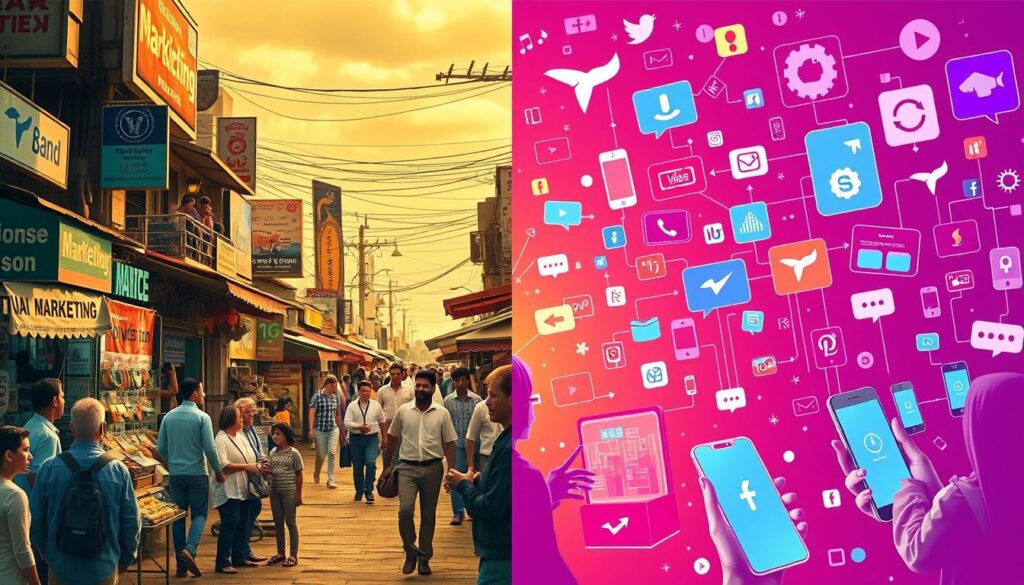
Looking at this shift, it’s clear that digital tools have often replaced traditional methods. Marketing has moved from billboards and print ads to online ads and social media. This shows a big change in how marketing responds to what customers need and new technology.
This change highlights a major move from old to new ways of marketing. It’s driven by new tech and a better understanding of customer relationships. Marketers play a big role in moving towards a digital world in marketing.
Transition of Influence: From Physical Billboards to Digital Ads
In an era where digital marketing is growing, physical billboards are giving way to digital ads. This change shows a big shift in how we advertise. Now, digital ads, with their dynamic nature, are becoming more important.
Billboards once dominated because of their size and reach. Now, digital ads, with their data-driven approach, are taking the lead. This shift is changing the way we connect with people.
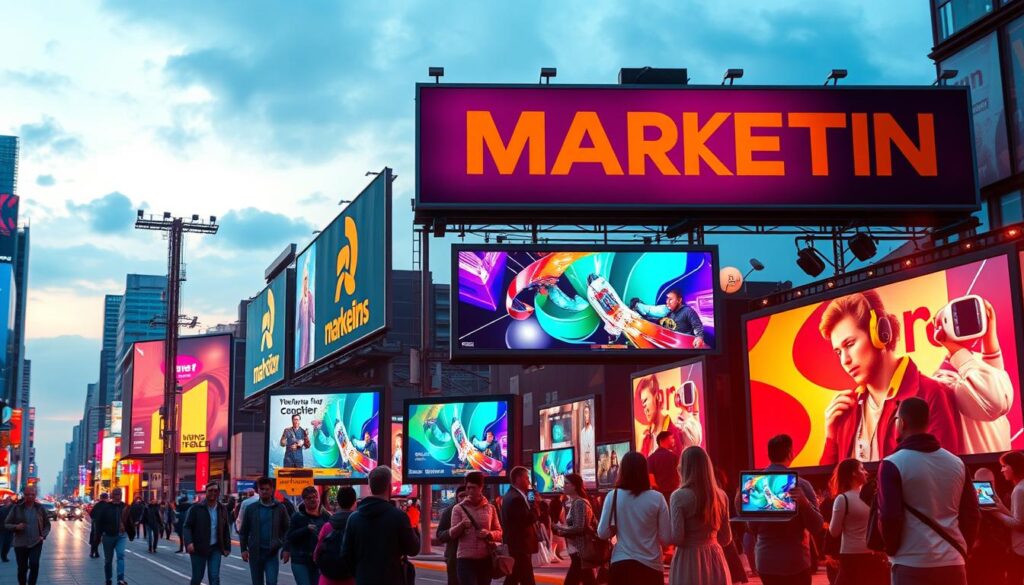
- Immediate Feedback and Analytics: Digital ads give quick insights into how effective a campaign is. This helps create better marketing strategies.
- User Engagement: Digital ads are interactive, unlike billboard ads. This interaction improves user experience and increases engagement.
- Precision Targeting: Digital ads can target specific groups. Platforms like Facebook and Twitter help reach certain demographics, interests, and behaviors. This was not possible with billboards.
- Cost Effectiveness: Digital ads can be adjusted to fit any budget. This is much cheaper than the costs tied to billboards.
The story of advertising is changing. Digital ads are now more important than billboards. This change is driven by technology and data. It brings new ways for brands to connect with people.
Adopting this change means more than just using new platforms. It means we have to change how we think about marketing. We need to focus on being responsive and precise in everything we do in digital marketing.
“The evolution of marketing from traditional to digital infographic”
Delving into the marketing’s transformation shows us a lot. Digital marketing infographics are more than just pretty pictures. They tell a powerful story. This marketing evolution timeline clarifies the role of digital strategies in today’s ads.
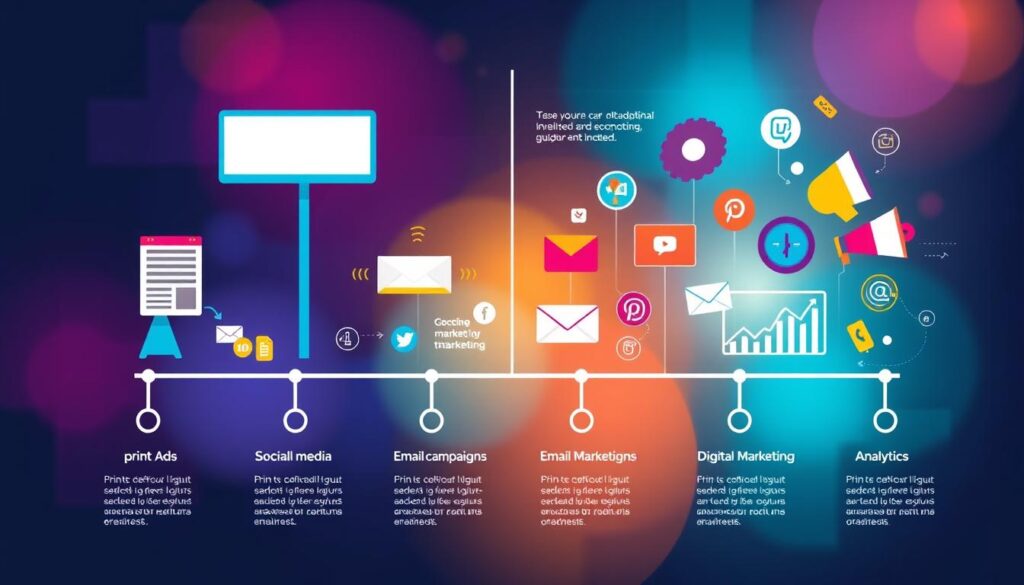
Weaving the Digital Thread into Advertising
The journey from early ads to today’s digital campaigns shows a significant change. Ads have moved from general to very targeted. Using data to grab and keep people’s attention online is now key.
The Pictorial Journey through Marketing’s History
This infographic marks key points like the first banner ad in 1994 and AdWords in 2000. It shows major steps in marketing’s history.
| Year | Marketing Milestone | Impact |
|---|---|---|
| 1704 | First Newspaper Advertisement | Birth of organized commercial advertising |
| 1922 | First Radio Advertisement | Expanding reach through audio messaging |
| 1941 | First Television Advertisement | Visual advertising becomes mainstream |
| 1978 | First Email Marketing Campaign | Direct and personalized marketing channel |
| 1994 | First Banner Ad | Introduction of digital advertising |
| 2000 | Launch of Google AdWords | Revolution in pay-per-click advertising |
| 2010 | Blockbuster Bankruptcy vs Netflix Growth | Shift to digital streaming and online rental services |
| Recent Years | Rise of AI Chatbots & Personalized Marketing | Enhanced user interactions and tailored experiences |
This timeline highlights how digital marketing infographics can appeal visually and teach us about changes in marketing. Graphical elements and data show how these changes keep influencing our ad strategies today.
Understanding Traditional Marketing Techniques
Marketing has changed a lot over time. Knowing traditional techniques helps us see how it moved to digital. This change is shown in the importance of digital marketing infographic. Traditional marketing included print media, TV ads, and mail. These played a key role in how we saw brands.
Ads in newspapers and on billboards were big parts of old marketing. These ads tried to grab everyone’s attention. TV and radio added stories to their ads, making them memorable.
But, these old ways had their problems. They were hard to measure and could cost a lot. This led to a big move towards digital. Now, SEO, social media, and data analytics are key, changing how we connect with brands.
This table shows the shift from old methods to digital ones. It compares different techniques and how they’ve changed:
| Traditional Marketing | Marketing digital |
|---|---|
| Print Media Advertisements | SEO and Website Content |
| Television Commercials | Social Media Campaigns |
| Radio Advertising | Podcasts and Audio Streaming Ads |
| Direct Mail | Email Newsletters |
| Outdoor Billboards | Mobile and Location-Based Marketing |
Looking at this change, we learn a lot. Understanding old marketing shows us the path to digital. Thanks to the importance of digital marketing infographic, we see the evolution. This helps us grasp how digital tech and analytics have changed marketing. Staying up with digital trends is crucial to staying ahead.
The Inception and Rise of Digital Marketing
Thinking about marketing changes, one big shift stands out. It’s going from old ways to digital marketing. The infographic on marketing evolution shows this big change well.
The start of digital marketing was with banner ads in the ’90s. Then came SEO. It made sure websites matched what search engines wanted. This made SEO very important for being seen online.
SEO: The Backbone of Digital Visibility
SEO changed a lot over time. It focused on better content and the right keywords. This helped websites show up higher in searches. The traditional vs digital marketing infographic shows this success.
Content Marketing: Engaging Audiences Meaningfully
Content marketing became key in talking to the right people. It uses good content to draw in and keep an audience. Social media and phones play a big role in this now.
Let’s look at how digital marketing works in different places:
- CRM tools help understand what people want by looking at data.
- Mobile Optimization is key because so many use their phones for everything.
- Social Media Marketing is always changing but it’s great for talking with customers.
Our new infographic shows how digital ways reach people better today. It shows the growth and depth of today’s marketing.
Looking back helps us see how much digital strategies have grown. It shows the importance of learning from changes. Staying up-to-date and flexible is crucial in marketing. It always has been and always will be.
Benefits of Embracing Digital Marketing Strategies
Digital marketing is not just about changing platforms. It’s a new way for brands to interact with people. By going digital, businesses reach more folks who are really interested in what they offer. They save money and learn a lot from the data they gather.
Digital marketing lets companies talk with customers right away. Whether on social media, through live chats, or updates, they connect faster. This fast connection lets businesses quickly see how people react to them. They can then change their plans to do better than before.
The world of digital marketing is always growing. It now uses AI and big data to find exactly who businesses want to reach. These new tools help companies use their resources better and reach the people they want more accurately.
Even small businesses can stand tall beside big companies thanks to digital channels. They can draw in nearby customers easily with SEO and social media ads. This works better for them than old methods like TV or radio ads.
- Increased brand visibility through consistent online presence
- Enhanced customer engagement with tailored content marketing strategies
- Higher conversion rates through personalized email marketing campaigns
- Cost-efficient customer acquisition via pay-per-click advertising
- Stronger customer loyalty through regular interaction and feedback on social media
Using a marketing trends infographic makes the benefits clearer to everyone. It helps teams understand digital marketing better, leading to smarter choices.
Digital marketing wins over old ways because it’s more flexible, precise, and efficient. It makes sure businesses are not only seen but also heard right. With the ongoing digital marketing evolution, it’s key for winning at marketing today.
Comparative Analysis: Traditional vs Digital Marketing Infographic
In today’s market, digital marketing is outpacing traditional methods. It offers unique advantages shown in an infographic. These strategies differ a lot in efficiency, cost, and how well they work.
Cost-Effectiveness and ROI: A Clear Distinction
Traditional vs digital marketing shows a big difference in cost-effectiveness. Traditional marketing costs more because it uses billboards and TV spots. On the other hand, digital marketing uses SEO and pay-per-click. This targets people more exactly, wastes less, and can give a better ROI.
Targeting Precision in the Digital Space
Digital marketing beats traditional methods in targeting accuracy. Traditional marketing reaches many but isn’t always relevant. Digital methods use analytics to find potential customers based on their behaviors and likes. This leads to better engagement, as many infographics show.
Here’s a close look at traditional vs digital marketing strategies:
| Aspect | Traditional Marketing | Marketing digital |
|---|---|---|
| Cost | Higher due to material and placement fees | Lower, with scalable options for all business sizes |
| Reach | Effective locally or broadly without precise targeting | Global reach with precision targeting capabilities |
| Compromiso | Limited interaction possible | High engagement through interactive and personalized content |
| Tracking & Analytics | Difficult to measure with precision | Real-time tracking with detailed analytics |
| Adaptability | Static with less flexibility to adapt | Highly adaptable with options to tweak campaigns in real time |
By using infographics to understand these marketing evolutions, businesses can choose how to spend their budgets. They can pick the most efficient and impactful method.
Unveiling the Power of Data in Digital Marketing
In digital marketing, data’s role is key. It leads the change to data-driven strategies. This shift beats traditional marketing in accuracy and tailoring. Now, our strength lies in how we use lots of data.
The marketing transformation infographic shows more money goes into online ads now. Digital advertising gets a bigger piece of the budget than old-fashioned ways. This big change shows how marketing is evolving.
| Marketing Type | Percentage Increase in Spending | Conversion Rate Improvement |
|---|---|---|
| Marketing digital | 65% | 35% |
| Traditional Advertising | 15% | 5% |
Social media’s role is growing, says the infographic. More businesses are focusing their money on Facebook, Instagram, and Twitter. They do this because these platforms can target people so well.
- Email Marketing: Emails made just for you get more people to open them, over 20% more.
- SEO: Good SEO can make web traffic jump by about 30%, helping bring in more leads.
- Content Marketing: Better content means 25% more people engaging, making your brand stronger.
Data tools are now key in marketing. They help see and fine-tune strategies as things happen. Using analytics means always getting better and knowing customers well. That’s what makes digital marketing work.
The change shown by the infographic on marketing evolution means more than new tools. It’s about changing how marketing talks to us. Data helps digital marketing keep getting better and smarter. This keeps marketing moving forward.
Marketing Trends Infographic: The Digital Shift Visualized
The landscape of digital marketing keeps changing. It changes because of new technology and how people act. The latest digital marketing infographic shows this change. It shows how online platforms have become important in marketing.
Depicting the Progressive March toward Digital Platforms
Infographics show the move from billboards to online ads. This change to digital is shown with great visuals. They highlight the rise of mobile marketing, personalized content, and big platforms like Instagram and LinkedIn.
Infographic Insights on Consumer Behavior Transition
It’s key to know how consumer behavior changes. A marketing trends infographic shows this big change. It reveals that people now want easy and personal services. This is thanks to AI and data analysis. Infographics show how people prefer to talk to brands instantly.
Infographics are not just for looks. They also teach us a lot in a simple way. They show trends that help plan future marketing moves and tech investments.
| Technology | Beneficios | Impact on Marketing |
|---|---|---|
| AI and Machine Learning | Personalized user experiences | Enhanced targeting and customer engagement |
| Chatbots | Instant customer support | Increased customer satisfaction and retention |
| Virtual Reality (VR) | Immersive brand experiences | Higher interaction rates in promotional activities |
| Blockchain Technology | Improved transparency in advertising | Boosts consumer trust through clearer ad spending |
| Content Clusters | Better topic authority in SEO | Improved search engine rankings and user engagement |
| Voice Search | Natural, conversational interface | Shift in keyword strategy to more conversational phrases |
The visuals and data in a marketing trends infographic show changes. They also hint at the future of digital marketing. It’s a mix of good looks and use. It makes complex data easy to understand and use.
Future Projections: The Continual Evolution of Digital Marketing
The digital marketing world changes all the time. It shows us a future filled with tech advancements. Understanding the importance of digital marketing infographic is key for anyone who wants to stay ahead. Let’s dive into the tech and strategies that will change marketing.
Personalization and AI: The Frontier of Marketing Innovation
AI is becoming a big part of digital marketing. It leads us to hyper-personalization. This means using AI to create unique experiences for each user. Those experiences are based on what users like and do. This makes people more engaged and marketing more effective.
- Predictive analytics: AI predicts what customers will do next, which changes the game.
- Automation: More tasks are automated now, making campaign management easier.
- Content creation: AI is making content that can adjust on its own. This makes personalization easier to do on a big scale.
The Impact of Voice Search and Smart Devices on Future Campaigns
Voice search and smart devices are changing digital marketing. They change how we give content and what that content is like. Now, content needs to be more natural and smart to work well with these technologies.
- Voice search optimization: Content for voice searches needs to be more like how we talk.
- Smart device integration: Marketing must now consider many kinds of devices. Messages must fit well into a connected way of living.
| Technology | Impact on Marketing | Predicted Trend |
|---|---|---|
| AI and Machine Learning | Enhanced personalization and automation of campaigns | Increasing use in predictive analytics and content creation |
| Voice Search and Smart Devices | Shift towards conversational marketing | Growth in voice-optimized content strategies |
| Metaverse and Immersive Tech | Emergence of new marketing platforms | Expansion into virtual brand experiences |
| Sustainability and 5G | Drive towards eco-friendly practices and enhanced connectivity | Increased focus on sustainability in marketing narratives |
It’s important to know the marketing transformation infographic. This shows us where marketing is headed. Sharing this knowledge helps you not just join, but lead, in digital marketing’s future.
Conclusión
We have seen big changes in marketing from the past to now. Our traditional vs digital marketing infographic shows this journey well. The internet has really changed how we connect with customers.
History shows us big shifts, like when email and social media started. These changes moved us from billboards to the digital space.
Now, AI and voice search are changing how we talk to customers. The 2020s will bring new tools like AR and VR. These will change how brands and people talk to each other.
Our talks showed digital marketing’s advantages, especially in making money and saving costs. The evolution of marketing from traditional to digital infographic explains this well. Digital platforms help us reach more people and engage with them better.
It’s important for businesses to keep up with new technology. Using digital marketing is a must to stay ahead. It helps make strong customer relationships, increases brand power, and fits well in our digital world.
FAQ
What marks the beginning of the shift from traditional to digital marketing?
The shift to digital marketing began with the internet’s rise. It brought clickable ads, email marketing, and SEO. These new tools changed how we do marketing, moving away from print, TV, and radio.
How did traditional advertising media like print ads and TV foster brand credibility?
Print ads were tangible, making them seem trustworthy. TV ads used stories, visuals, and sound. This mix created powerful, memorable messages. They reached large numbers of people.
What is the significance of direct mail in marketing history?
Direct mail mattered because it felt personal. It let marketers target specific groups with their messages. This approach often led to better responses than wider ad methods.
How have physical billboards transitioned with the rise of digital marketing?
Before, billboards were everywhere. Now, digital ads are more precise. They let us interact and measure success directly. Digital tech has changed visibility.
What role has SEO played in the evolution of digital marketing?
SEO made websites more visible. It helps businesses show up earlier in search results. This means more people can find them which boosts customer interactions.
How does content marketing differ from traditional advertising?
Content marketing shares useful info, building trust without pushing sales. Traditional ads often aimed directly at selling. This difference changes how brands connect with us.
What are the main benefits of embracing digital marketing strategies?
Digital marketing is cheaper and more precise. It lets you reach the whole world, see results in real time, and change plans fast. This agility is key.
How does digital marketing offer better cost-effectiveness and ROI than traditional marketing?
With digital marketing, you can track how consumers act and how campaigns perform. This info helps spend your budget smarter and get better returns through targeting.
In what ways does data empower digital marketing?
Data guides smart decisions, makes personal experiences, and shows trends. This makes campaigns more effective. It’s about understanding what people want and doing it well.
How do marketing trends infographics help illustrate the digital marketing evolution?
Infographics make it easy to see how marketing has changed. They show how people’s habits shift and why digital matters. It’s a clear, simple way to learn.
Why is personalization in digital marketing seen as a significant trend for the future?
Personalization talks directly to what people like and do. It makes experiences just for them. This boosts loyalty and sales. Data analysis and AI make it happen.
How might voice search and smart devices impact future marketing campaigns?
Voice search and smart devices change SEO, content, and how we talk to customers. Marketers must adapt to more casual searches and hands-free use. It’s a big shift.

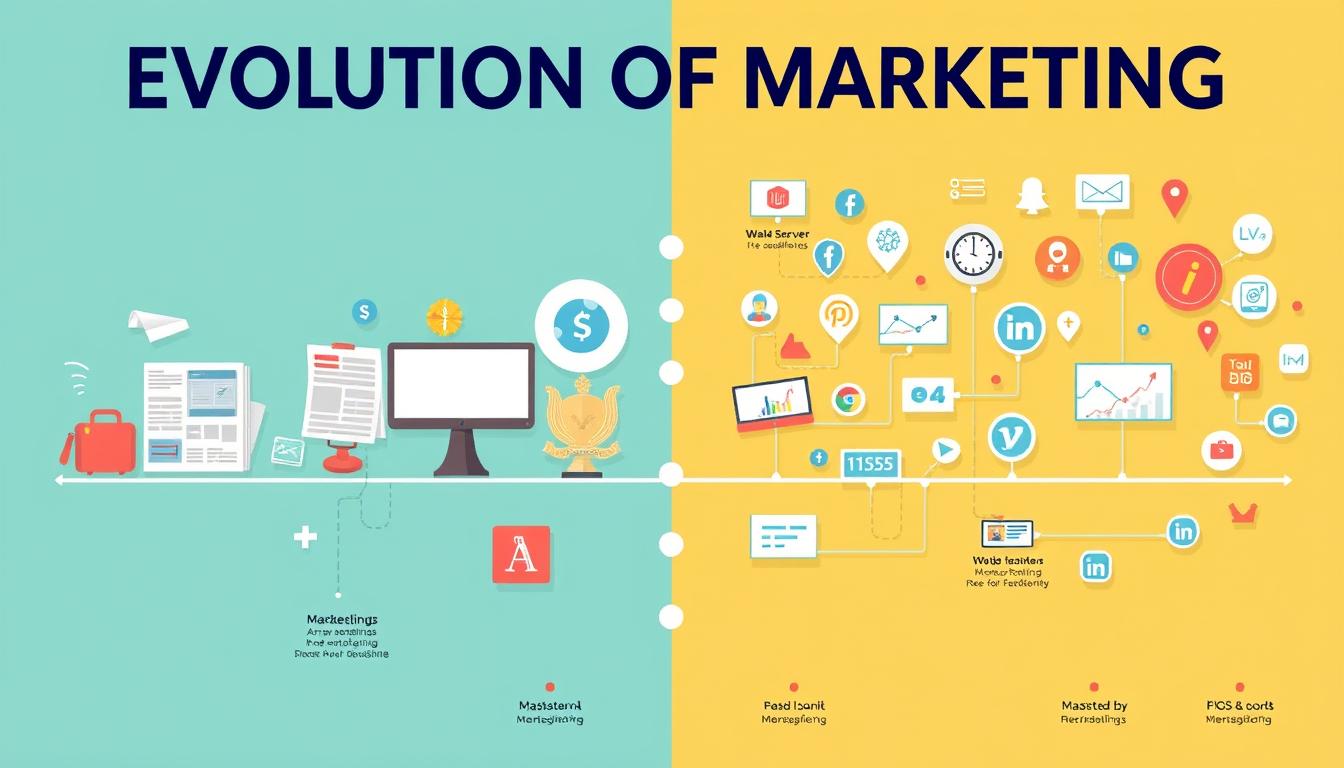
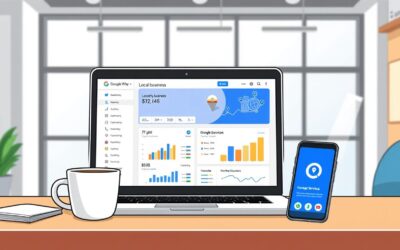

0 comentarios